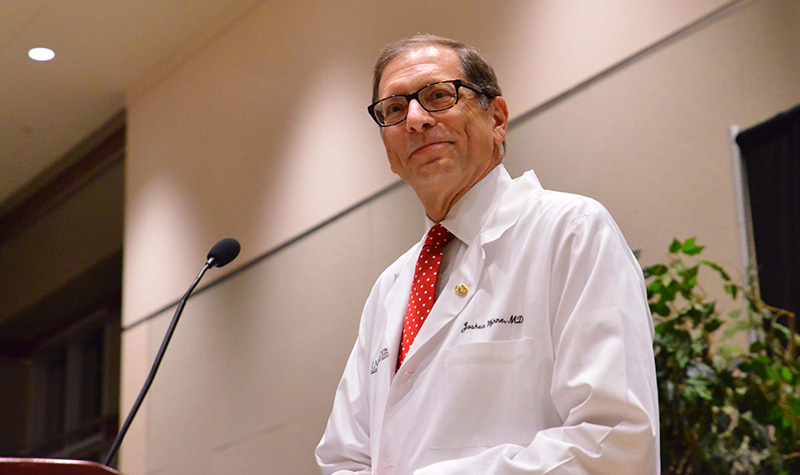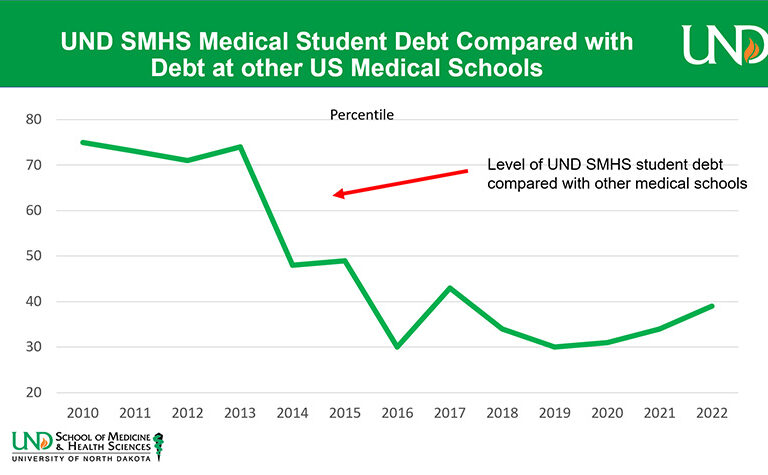From the Dean

Like many of you, I’ve been going nonstop and trying to manage the evolving coronavirus (COVID-19) situation and its impact. What follows, then, are the latest updates pertaining to the UND School of Medicine & Health Sciences, and a longer version of an op-ed I wrote that was published by the state’s major newspapers this week.
First, please note the new COVID-19 updates page on our own SMHS website. As you know, all non-essential UND personnel are working remotely until at least April 4, and we are in close contact with Governor Burgum’s office and city leaders on how developments in communities across the state housing SMHS faculty, staff and students are responding to the situation.
As far as education is concerned, we have temporarily shifted our preclinical educational paradigm for medical and health sciences students to deliver content electronically rather than asking students to come to class. Even group exercises are being conducted in this fashion. Faculty and students have been flexible and creative, and this has been very successful so far.
In the clinical arena, consistent with strong recommendations from the Association of American Medical Colleges (AAMC), we have removed our medical students from the health care delivery system through the end of the month to reduce utilization of personal protective equipment, allow for time to train students specifically for this clinical environment, and allow time for deliberation and planning. This will be continually reassessed in collaboration with our health care delivery partners.
Likewise, all health sciences students who were on clinical rotations have been temporarily pulled from the clinics.
Meanwhile, although we continue to pursue our research goals at the SMHS, we have taken steps to ensure employee safety, including moving group meetings online and practicing social distancing.
But life goes on, and we should all try to celebrate the small wins when we can. For example, today is the National Resident Matching Program’s Match Day. This is the day all graduating medical students learn of their residency match. Although the Match Day events on all four SMHS campuses in North Dakota have been canceled, students will still learn where they’ll be spending the next three to five years in residency. So, we’re hoping all students get the match they want and join them in marking this milestone moment in their young careers.
Finally, you already may have seen the op-ed article from me online and in the State’s largest newspapers in which I share my thoughts and insights on the ongoing COVID-19 pandemic. The newspapers were extremely accommodating in finding time and space to include the article on short notice. That said, the newspapers do have article length and space limitations to consider. My original draft needed to be cut down considerably in preparation for publication.
With this message, you will find the longer, more complete version of my article. In consultation with North Dakota University System Chancellor Mike Hagerott and others, we felt, given the gravity of the current pandemic, the anxieties that it is producing and the desire for new information and perspectives, that it might be useful to share the fuller article more broadly.
In penning my op-ed, I momentarily checked my hat as interim president of the University of North Dakota at the door and donned my “white coat” as our University’s vice president for Health Affairs, dean of your School of Medicine & Health Sciences and a physician who’s dedicated nearly a half-century to the betterment of human health. I hope you will find my words to be helpful, enlightening and maybe even inspiring as we navigate these challenging times together.
Please don’t forget to take care of yourself, and be healthy, safe and well:
Short-Term Pain for Long-Term Gain
The current situation with SARS-CoV-2 (also known as coronavirus and COVID-19) is confusing, anxiety-producing—and scary. The majority of people typically have mild or even no symptoms. But several countries—China, South Korea and now northern Italy—have been or are being inundated with large numbers of very sick, often elderly, patients.
What truly is scary is how quickly the hospitals and health care systems in those countries (which especially in northern Italy and South Korea are excellent) became completely inundated and overwhelmed—in the case of Italy, over a time period of only a few weeks! And I mean overwhelmed—unable to care for all of the desperately ill people who were presenting to their emergency departments, clinics, and hospitals, compounded by the associated illness and deaths of some of the very health care providers who were valiantly trying to help.
Those experiences are eerily reminiscent of similar ones that were reported during the influenza pandemic of 1918 that killed somewhere around 50 million people around the globe. A colleague recently recounted how his grandfather who lived through that “Spanish flu” pandemic would tearfully recount the loss of many brave young nurses to the flu, including one he had grown especially attached to as a 19-year-old soldier.
After initially being flooded with patients, China and South Korea responded with very aggressive measures to limit the spread of the virus—and it has paid off, with a dramatic decrease in the number of new cases. This has been called “flattening the curve,” referring to a curved line that reflects the rise in the number of new cases. A flattened curve rises less rapidly, doesn’t go as high, flattens, and then falls over time. Perhaps even more importantly, countries like Taiwan, Singapore, and Hong Kong responded early, and aggressively, and essentially stopped the outbreak before it gained a foothold.
So what accounted for this dramatic change? Part of it was due to effective identification and isolation of people spreading the disease through widespread viral testing. Part of it was due to common-sense public health measures like washing one’s hands with warm soapy water for 20 seconds. But perhaps most important was simply keeping people apart so they couldn’t physically pass the virus to someone else. We call this social distancing, and it means just that—limiting the physical contact we have with others by keeping our distance. It includes encouraging people to work from home, closing schools and other institutions, and eliminating events that are associated with crowds.
The most important component is this commitment of each and every citizen to keep one’s distance from others. That means not going to restaurants, health clubs, parties, malls—or even church. Draconian? Perhaps. Major negative economic impact? Definitely. Inconvenient? For sure. Effective? You bet! These are the things that proved effective in China and South Korea. We have the chance to do them now, before the near-inevitable catastrophe occurs here.
Two qualities in North Dakotans that have impressed me over the years are their sense of personal responsibility, and their willingness to help out a neighbor in need (such as in times of floods). Well, we don’t have just a flood facing us with SARS-CoV-2—we have a tsunami! However, if each North Dakotan saw it as his or her personal and individual responsibility to really practice social distancing and the other common-sense measures like frequent hand-washing, we could limit the coming rapid growth of cases that otherwise is almost certainly destined to occur, “flatten the curve,” and thus help ourselves and our families, as well as our friends and neighbors. We all have to be involved in this effort and really mean it.
There is a clear choice for us right now—are we prepared for some short-term pain in exchange for long-term gain? I’m confident that the answer is “yes,” so let’s get at it—now!
Practical Suggestions:
- Work from and stay at home as much as possible
- Stay at least six feet away from anyone
- Avoid anyone who has a “cold” or other respiratory symptoms
- Do not get into any group setting, especially one with more than a few (maybe five or so) people
- Avoid restaurants, gyms, bars, malls, churches, and other places where people gather
- Avoid touching your face if you haven’t washed your hands for 20 seconds or used a hand sanitizer
- Avoid travel unless it truly is essential
- If you develop cold symptoms (runny nose, fever, cough), you should stay home, contact your health care provider, and avoid potentially exposing others until you are cleared by your provider
- Think how you might be able to support your neighbor who must go to work, such as our health care workers (many of whom might be young parents needing childcare and other forms of support)
Thanks, as always, for your service. And stay healthy!
Joshua Wynne, MD, MBA, MPH
Interim President and Vice President for Health Affairs, UND
Dean, UND School of Medicine & Health Sciences


